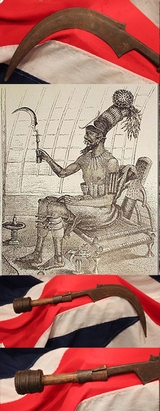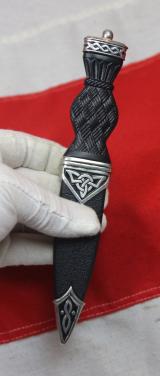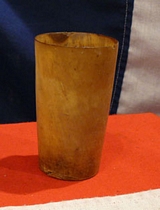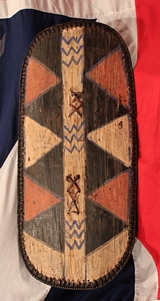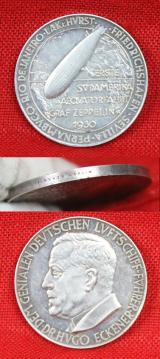Antique Zulu-Tsonga Prestige Staff Possibly Carved by a Carver Known as the 'Baboon Master'. With a Carved Female Head
19th century. This dignatory's staff has a most figurative carving. They have been collected in Southern Africa since the mid-19th century. Recent research by Anitra Nettleton suggests, however, that Tsonga sculptors may actually have produced most of these carvings. There is evidence that the Tsonga migrated to the Natal from southern Mozambique as early as the 1850s. Recognized for their carving skills, they were soon producing fine artifacts for Zulu dignatories. Two related staffs, were purchased for the collection of the Standard Bank Foundation in Johannesburg. One staff of theirs is surmounted by a baboon and the other by a male figure with a beard. Both are said to be turn-of-the-century staffs carved by the same hand, by a most accomplished and sought after artist dubbed the 'Baboon Master', who was possibly of Tsonga origin. 31 inches long. read more
750.00 GBP
A Rare 19th Century King's Knife of the Zande or the Mengbetu People, A Trombash Power Authority Knife
A long Knife consisting of a short cylindrical wooden handle, round in section, with a flat end bound in iron banding at the pommel end. The other end of this is cut flat, and has a smaller cylindrical body as the middle hand grip section. Above this point, the handle connects with the blade tang. Which goes through the handle, the tang has been inserted through the centre of the handle, and then its rectangular end hammered over at the top to fix it in place. This is end is visible where it emerges through the handle top, and is off centre. The narrower part of the handle have been decorated with an iron binding strip. Both binding strips [top and bottom] have their ends hammered into slots in the wood to secure them. The blade is curved, with a broad flat ridge running along the length on both sides. This is not centred. On one side of the ridge, the blade extends to form a broad, sharpened base edge with a pointed corner; a more narrow blade extends from the other side of this, slightly higher up the knife. The sides then begin to taper in towards the point at the other end. Both edges were once sharpened. The object is complete, with some minor cut marks on the blade and handle.
Very similar to a Mengbetu collected by Robert Grenville Gayer-Anderson in the Bahr el Ghazal region, probably between 1909 and 1914, in the period immediately before World War I. At the time this object was collected, the Bahr el Ghazal province was much larger than it is today, extending from roughly the Bahr el Arab all the way to the border with the Belgian Congo; this area is now divided into the districts of Western Bahr el Ghazal, Northern Bahr el Ghazal, and parts of Warab, El Buheyrat and Western Equatoria. The drawing in the gallery is a 19th century depiction of Munza, the king of the Mangbetu. Seated on his throne, he holds a similar knife to ours as a symbol of power and authority. read more
395.00 GBP
A Beautiful Sword of the Mandinka, West African, with Elaborate Decorative Fittings 20th. Century
Curved on both sides, fluted back blade with baluster contrast stitching and leather-covered handle. Geometrically patterned leather scabbard with traditional banding patterns, stitched raffia decorations and braided suspension cords and leather fringe tassels.
In some areas they are referred to locally as termed a 'kota' and that the scabbard was termed 'holga' ( house 'for the sword')
The Mandinka are the descendants of the Mali Empire, which rose to power in the 13th century under the rule of king Sundiata Keita, who founded an empire that would go on to span a large part of West Africa. They migrated west from the Niger River in search of better agricultural lands and more opportunities for conquest. Nowadays, the Mandinka inhabit the West Sudanian savanna region extending from The Gambia and the Casamance region in Senegal to Ivory Coast. Although widespread, the Mandinka constitute the largest ethnic group only in the countries of Mali, Guinea and The Gambia. Most Mandinka live in family-related compounds in traditional rural villages. Their traditional society has featured socially stratified castes.Mandinka communities have been fairly autonomous and self-ruled, being led by a chief and group of elders. Mandinka has been an oral society, where mythologies, history and knowledge are verbally transmitted from one generation to the next. Their music and literary traditions are preserved by a caste of griots, known locally as jelis, as well as guilds and brotherhoods like the donso (hunters).
Between the 16th and 19th centuries, many Muslim and non-Muslim Mandinka people, along with numerous other African ethnic groups, were captured, enslaved and shipped to the Americas. They intermixed with slaves and workers of other ethnicities, creating a Creole culture. The Mandinka people significantly influenced the African heritage of descended peoples now found in Brazil, the Southern United States and, to a lesser extent, the Caribbean read more
195.00 GBP
Celtic Sgian Dubh with Polished Pewter Celtic Knotwork Patterned Mounts. For Wear In Full Highland Dress,
Ball knop top. A bright polished steel blade in a Sgian Dubh presentation box.
The sgian-dubh is a small, single-edged knife worn as part of traditional Scottish Highland dress along with the kilt. Originally used for eating and preparing fruit, meat, and cutting bread and cheese, as well as serving for other more general day-to-day uses such as cutting material and protection, it is now worn as part of traditional Scottish dress tucked into the top of the kilt hose with only the upper portion of the hilt visible. The sgian-dubh is normally worn on the same side as the dominant hand.
The sgian-dubh may have evolved from the sgian-achlais, a dagger that could be concealed under the armpit. Used by the Scots of the 17th and 18th centuries, this knife was slightly larger than the average modern sgian-dubh and was carried in the upper sleeve or lining of the body of the jacket.
Courtesy and etiquette would demand that when entering the home of a friend, any concealed weapons would be revealed. It follows that the sgian-achlais would be removed from its hiding place and displayed in the stocking top held securely by the garters
Vintage, around 10 years old read more
45.00 GBP
A Most Charming Napoleonic Wars King George IIIrd Royal Scot's Greys Officer's Carved Horn, Campaign Drinking Cup
In carved horn used from the 1790's by a British Napoleonic Wars officer in the Royal Scot's Greys, then by his grandson in the Crimean war. A super Napoleonic Wars collectable.
Campaign furniture is an umbrella term for the portable items of furniture used by the military in the eighteenth, nineteenth and early twentieth centuries. It is comprised of a huge number of objects, from leatherwork, knives and forks, flasks, drinking vessels, chairs to chests, wardrobes to washstands and games tables to camp beds. from chairs to chests, wardrobes to washstands and games tables to camp beds. A number of celebrated British furniture makers created pieces of campaign furniture, elevating it beyond its roots in functional, army-based design to desirable, collectable decor that continues to add a beautiful, innovative touch to homes today. read more
145.00 GBP
A Most Scarce and Beautiful African Congo Tribal Warrior's Shield, of the Mongo Tribe.
Long ovoid form shield with stunning geometric pattern decoration. Carved wood with rattan bound edging.
The Mongo are one of the Bantu groups of Central Africa, forming the second largest ethnic group in the Democratic Republic of Congo. They are a diverse collection of peoples living in the equatorial forest, south of the main Congo River bend and north of the Kasai and Sankuru Rivers. This area is in the south of the province of Equateur and the north of Bandundu Province.
The Mongo speak either the Mongo language (also called Nkundo) or one of the related languages in the Bantu Mongo family. The Lingala language, however, often replaces Mongo in urban centers. Along with the Luba and the Kongo, they are the three largest ethnic groups in the country.
The Mongo ethnic group is divided into several tribes including Bolia, Bokote, Bongandu, Iyaelima, Konda, Mbole, Nkutu, Ntomba, Sengele, Songomeno, Dengese and Tetela-Kusu, Bakutu, Boyela.
Antique & Vintage original African tribal art is now some of the most desirable and sophisticated decor for national and international interior decorators.
Fine tribal artefacts have always been highly popular and in regards to interior decor, the height of sophistication, but recently it has become absolutely 'the' collectable art of the moment. As to be seen from far afield interiors such as in the 8th Arrondissement, in Paris particularly Avenue Montaigne, to Park Avenue New York, to Kensington Palace Gardens in London or the Piazza di Spagna, Via Condotti and Via del Babuino in Rome. All of the above we have had clients for such African tribal art and weaponry, as a statement focal point for their interior decor.
Super colour contrasts and design incorporating red ochre, cobalt blue, black and white. Red ochre is one of the very earliest pigments used by man, dating back to prehistoric times where it’s use is the basis of many Stone Age cave paintings
Overall in very good condition for age.
16 inches x 35 inches read more
875.00 GBP
The Lanes Armoury & Bookshop. Military Based Books, Historical, Biographical, Reference, & Fictional. From Ancient to Modern 1st Editions & Autographed. We Are Now The Last, Original, Antique Bookshop in Brighton.
Since the very sad closure, after too many decades to recall, of our friend and colleague’s antique and secondhand bookshop Colin Page, just around the corner in Duke St. we are one of last of our kind, selling antique and modern books locally.
Although, fortunately, there are still just a few new, vintage and as new bookshops [and one comic shop] still remaining. We specialise in Ist Editions by such as Charles Dickens, Winston Churchill, Charles Darwin, John Le Carre, Ian Fleming, and Rudyard Kipling.
With or without dust jackets, autographed copies especially desired. We have £25,000 awaiting for another Signed Ist Edition Charles Dickens Christmas Carol. We regularly stock thousands of books, but as they are our largest individual selling item, many under just £10 to £50, they come and go so fast that individual listing is too impractical. But we do list on this website a good selection of our 1st Editions and specialist books.
If you require a military, or historical book, either antique or modern, please email a request, stating; title, author, and publisher [if known].
Large quantity book purchases [over 30 volumes] can attract discounts wherever possible. We specialise in hardbacks, both for reference or the study of history, and 'coffee table' books. We also specialise in rare medieval books, leaves from the versions of illustrated Book of Hours, signed Ist Editions, autographed books and manuscripts, and Incunabula [ volumes printed before 1501]
During lockdown we offered a unique drop off and sell and drop in and collect no contact service at our farm. It was incredibly popular many driving from as far north as Birmingham. It was easily our most popular trade during those months, showing just how eager those isolated could reward themselves with an ample supply of well needed reading material. Some buying or selling up to 50 books at a time. read more
Price
on
Request
A Magnificent & Fabulous Quality Antique French Rococo Silver Table Lamp
A wonderful example of the finest antique silver plate. Superlative quality of the highest grade, and of the most incredible beauty, from the Rococo Revival period that emerged from the King Louis Phillipe and Second Empire eras in France, and was then adapted in England. Revival of the rococo style was seen all throughout Europe during the 19th century within a variety of artistic modes and expression including decorative objects of art, paintings, art prints, furniture, and interior design. In much of Europe and particularly in France, the original rococo was regarded as a national style, and to many, its re-emergence recalled national tradition. Rococo revival epitomized grandeur and luxury in European style and was another expression of 19th century romanticism and the growing interest and fascination with natural landscape. Louis Philippe (1830-1848)
The rising bourgeoisie in France demanded rococo decorative-art objects as a reflection of status, wealth, and material possession. The bourgeois consumer purchased objects and furnishings from a variety of revival styles, including rococo, for its significance in historicizing opulence and grandeur.
Modern French Rococo furniture and decorative arts were characterized by their opulence elegance and grace. Its ornamentation consisted of delicate foliage and intricate details.13.5 inches x 8 inches. Excluding light fitting. Very heavy quality. read more
895.00 GBP
A Very Fine 1920's to 30's Silver Gilt & Enamel Graf von Zeppelin Demi-Tasse Cabinet Spoon, With Enamel Portrait of Zeppelin & a Zeppelin Airship in the Spoon Bowl
Superb condition and a most charming and collectable object d'art. Ferdinand von Zeppelin served as an official observer with the Union Army during the American Civil War. During the Peninsular Campaign, he visited the balloon camp of Thaddeus S. C. Lowe. Lowe sent the curious von Zeppelin to another balloon camp where the German-born aeronaut John Steiner could be of more help to the young man. His first ascent in a balloon, made at Saint Paul, Minnesota during this visit, is said to have been the inspiration of his later interest in aeronautics.
Zeppelin's ideas for large dirigibles was first expressed in a diary entry dated 25 March 1874. Inspired by a recent lecture given by Heinrich von Stephan on the subject of "World Postal Services and Air Travel", he outlined the basic principle of his later craft: a large rigidly-framed outer envelope continuing a number of separate gasbags. In 1887 the success of Charles Renard and Arthur Krebs' airship La France prompted him to send a letter to the King of Württemberg about the military necessity for dirigibles and the lack of German development in this field. He went on to start the Zeppelin Airship Co. and his name lived on in German legend as the great airship pioneer of international travel and airship warfare. read more
235.00 GBP
A Rare German Aerospace Zeppelin First Flight To South America, .835 Silver Medal, 1930 Made In Berlin
Silver medal 1930 (O. Glöckler) The "LZ 127" made its first trip to South America. bust of dr. H. Eckener to the left / Airship over the Atlantic between Europe and South America. Edge punch: (half moon) 835 PR. BERLIN COIN. 36 mm, 24.59 Min. Scratches. excellent ++ condition
LZ 127 Graf Zeppelin (Deutsches Luftschiff Zeppelin 127) was a German passenger-carrying, hydrogen-filled rigid airship that flew from 1928 to 1937. It offered the first commercial transatlantic passenger flight service. Named after the German airship pioneer Ferdinand von Zeppelin, a count (Graf) in the German nobility, it was conceived and operated by Dr. Hugo Eckener, the chairman of Luftschiffbau Zeppelin.
Graf Zeppelin made 590 flights totalling almost 1.7 million kilometres (over 1 million miles). It was operated by a crew of 36, and could carry 24 passengers. It was the longest and largest airship in the world when it was built. It made the first circumnavigation of the world by airship, and the first nonstop crossing of the Pacific Ocean by air; its range was enhanced by its use of Blau gas as a fuel. It was built using funds raised by public subscription and from the German government, and its operating costs were offset by the sale of special postage stamps to collectors, the support of the newspaper magnate William Randolph Hearst, and cargo and passenger receipts.
After several long flights between 1928 and 1932, including one to the Arctic, Graf Zeppelin provided a commercial passenger and mail service between Germany and Brazil for five years. When the Nazi Party came to power, they used it as a propaganda tool. It was withdrawn from service after the Hindenburg disaster in 1937, and scrapped for military aircraft production in 1940.
A most scarce piece, but remarkably we acquired this fine example thanks to another example that we have. That past medal was spotted by this rare medal's owner on our website, and they offered it to us. It is only the second of its type of this rare medal we have had in over 10 years. read more
260.00 GBP



